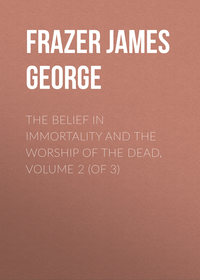 полная версия
полная версияThe Golden Bough: A Study in Magic and Religion (Third Edition, Vol. 03 of 12)
Knots may be used to cure disease.
If knots are supposed to kill, they are also supposed to cure. This follows from the belief that to undo the knots which are causing sickness will bring the sufferer relief. But apart from this negative virtue of maleficent knots, there are certain beneficent knots to which a positive power of healing is ascribed. Pliny tells us that some folk cured diseases of the groin by taking a thread from a web, tying seven or nine knots on it, and then fastening it to the patient's groin; but to make the cure effectual it was necessary to name some widow as each knot was tied.1118 The ancient Assyrians seem to have made much use of knotted cords as a remedy for ailments and disease. The cord with its knots, which were sometimes twice seven in number, was tied round the head, neck, or limbs of the patient, and then after a time cut off and thrown away, carrying with it, as was apparently supposed, the aches and pains of the sufferer. Sometimes the magic cord which was used for this beneficent purpose consisted of a double strand of black and white wool; sometimes it was woven of the hair of a virgin kid.1119 A modern Arab cure for fever reported from the ruins of Nineveh is to tie a cotton thread with seven knots on it round the wrist of the patient, who must wear it for seven or eight days or till such time as the fever passes, after which he may throw it away.1120 O'Donovan describes a similar remedy for fever employed among the Turcomans. The enchanter takes some camel hair and spins it into a stout thread, droning a spell the while. Next he ties seven knots on the thread, blowing on each knot before he pulls it tight. This knotted thread is then worn as a bracelet on his wrist by the patient. Every day one of the knots is untied and blown upon, and when the seventh knot is undone the whole thread is rolled up into a ball and thrown into a river, bearing away (as they imagine) the fever with it.1121 The Hos of Togoland in like manner tie strings round a sick man's neck, arms, or legs, according to the nature of the malady; some of the strings are intended to guard him against the influence of “the evil mouth”; others are a protection against the ghosts of the dead.1122 In Argyleshire, threads with three knots on them are still used to cure the internal ailments of man and beast. The witch rubs the sick person or cow with the knotted thread, burns two of the knots in the fire, saying, “I put the disease and the sickness on the top of the fire,” and ties the rest of the thread with the single knot round the neck of the person or the tail of the cow, but always so that it may not be seen.1123 A Scotch cure for a sprained leg or arm is to cast nine knots in a black thread and then tie the thread round the suffering limb, while you say:
“The Lord rade,And the foal slade;He lightedAnd he righted,Set joint to joint,Bone to bone,And sinew to sinew.Heal, in the Holy Ghost's name!”1124In Gujarat, if a man takes seven cotton threads, goes to a place where an owl is hooting, strips naked, ties a knot at each hoot, and fastens the knotted thread round the right arm of a man sick of the fever, the malady will leave him.1125
Knots may be used to win a lover or capture a runaway slave.
Again, knots may be used by an enchantress to win a lover and attach him firmly to herself. Thus the love-sick maid in Virgil seeks to draw Daphnis to her from the city by spells and by tying three knots on each of three strings of different colours.1126 So an Arab maiden, who had lost her heart to a certain man, tried to gain his love and bind him to herself by tying knots in his whip; but her jealous rival undid the knots.1127 On the same principle magic knots may be employed to stop a runaway. In Swazieland you may often see grass tied in knots at the side of the footpaths. Every one of these knots tells of a domestic tragedy. A wife has run away from her husband, and he and his friends have gone in pursuit, binding up the paths, as they call it, in this fashion to prevent the fugitive from doubling back over them.1128 When a Swaheli wishes to capture a runaway slave he will sometimes take a string of coco-nut fibre to a wise man and get him to recite a passage of the Koran seven times over it, while at each reading the wizard ties a knot in the string. Then the slave-owner, armed with the knotted string, takes his stand in the door of the house and calls on his slave seven times by name, after which he hangs the string over the door.1129
Knots tied by hunters and travellers.
The obstructive power of knots and locks as means of barring out evil manifests itself in many ways. Thus on the principle that prevention is better than cure, Zulu hunters immediately tie a knot in the tail of any animal they have killed, because they believe that this will hinder the meat from giving them pains in their stomachs.1130 An ancient Hindoo book recommends that travellers on a dangerous road should tie knots in the skirts of their garments, for this will cause their journey to prosper.1131 Similarly among some Caffre tribes, when a man is going on a doubtful journey, he knots a few blades of grass together that the journey may turn out well.1132 In Laos hunters fancy that they can throw a spell over a forest so as to prevent any one else from hunting there successfully. Having killed game of any kind, they utter certain magical words, while they knot together some stalks of grass, adding, “As I knot this grass, so let no hunter be lucky here.” The virtue of this spell will last, as usually happens in such cases, so long as the stalks remain knotted together.1133 The Yabims of German New Guinea lay a knot in a fishing-boat that is not ready for sea, in order that a certain being called Balum may not embark in it; for he has the power of taking away the fish and weighing down the boat.1134
Knots and locks used as protective amulets in Russia and elsewhere.
In Russia amulets often derive their protective virtue in great measure from knots. Here, for example, is a spell which will warrant its employer against all risk of being shot: “I attach five knots to each hostile, infidel shooter, over arquebuses, bows, and all manner of warlike weapons. Do ye, O knots, bar the shooter from every road and way, lock fast every arquebuse, entangle every bow, involve all warlike weapons, so that the shooters may not reach me with their arquebuses, nor may their arrows attain to me, nor their warlike weapons do me hurt. In my knots lies hid the mighty strength of snakes – from the twelve-headed snake.” A net, from its affluence of knots, has always been considered in Russia very efficacious against sorcerers; hence in some places, when a bride is being dressed in her wedding attire, a fishing-net is flung over her to keep her out of harm's way. For a similar purpose the bridegroom and his companions are often girt with pieces of net, or at least with tight-drawn girdles, for before a wizard can begin to injure them he must undo all the knots in the net, or take off the girdles. But often a Russian amulet is merely a knotted thread. A skein of red wool wound about the arms and legs is thought to ward off agues and fevers; and nine skeins, fastened round a child's neck, are deemed a preservative against scarlatina. In the Tver Government a bag of a special kind is tied to the neck of the cow which walks before the rest of a herd, in order to keep off wolves; its force binds the maw of the ravening beast. On the same principle, a padlock is carried thrice round a herd of horses before they go afield in the spring, and the bearer locks and unlocks it as he goes, saying, “I lock from my herd the mouths of the grey wolves with this steel lock.” After the third round the padlock is finally locked, and then, when the horses have gone off, it is hidden away somewhere till late in the autumn, when the time comes for the drove to return to winter quarters. In this case the “firm word” of the spell is supposed to lock up the mouths of the wolves. The Bulgarians have a similar mode of guarding their cattle against wild beasts. A woman takes a needle and thread after dark, and sews together the skirt of her dress. A child asks her what she is doing, and she tells him that she is sewing up the ears, eyes, and jaws of the wolves so that they may not hear, see, or bite the sheep, goats, calves, and pigs.1135 Similarly in antiquity a witch fancied that she could shut the mouths of her enemies by sewing up the mouth of a fish with a bronze needle,1136 and farmers attempted to ward off hail from their crops by tying keys to ropes all round the fields.1137 The Armenians essay to lock the jaws of wolves by uttering a spell, tying seven knots in a shoe-lace, and placing the string between the teeth of a wool-comber, which are probably taken to represent the fangs of a wolf.1138 And an Armenian bride and bridegroom will carry a locked lock on their persons at and after marriage to guard them against those evil influences to which at this crisis of life they are especially exposed.1139 The following mode of keeping an epidemic from a village is known to have been practised among the Balkan Slavs. Two old women proceed to a spot outside the village, the one with a copper kettle full of water, the other with a house-lock and key. The old dame with the kettle asks the other, “Whither away?” The one with the lock answers, “I came to lock the village against mishap,” and suiting the action to the words she locks the lock and throws it, together with the key, into the kettle of water. Then she strides thrice round the village, each time repeating the performance with the lock and kettle.1140 To this day a Transylvanian sower thinks he can keep birds from the corn by carrying a lock in the seed-bag.1141 Such magical uses of locks and keys are clearly parallel to the magical use of knots, with which we are here concerned. In Ceylon the Singhalese observe “a curious custom of the threshing-floor called ‘Goigote’ – the tying of the cultivator's knot. When a sheaf of corn has been threshed out, before it is removed the grain is heaped up and the threshers, generally six in number, sit round it, and taking a few stalks, with the ears of corn attached, jointly tie a knot and bury it in the heap. It is left there until all the sheaves have been threshed, and the corn winnowed and measured. The object of this ceremony is to prevent the devils from diminishing the quantity of corn in the heap.”1142 Knots and locks may serve to avert not only devils but death itself. When they brought a woman to the stake at St. Andrews in 1572 to burn her alive for a witch, they found on her a white cloth like a collar, with strings and many knots on the strings. They took it from her, sorely against her will, for she seemed to think that she could not die in the fire, if only the cloth with the knotted strings was on her. When it was taken away, she said, “Now I have no hope of myself.”1143 In many parts of England it is thought that a person cannot die so long as any locks are locked or bolts shot in the house. It is therefore a very common practice to undo all locks and bolts when the sufferer is plainly near his end, in order that his agony may not be unduly prolonged.1144 For example, in the year 1863, at Taunton, a child lay sick of scarlatina and death seemed inevitable. “A jury of matrons was, as it were, empanelled, and to prevent the child ‘dying hard’ all the doors in the house, all the drawers, all the boxes, all the cupboards were thrown wide open, the keys taken out, and the body of the child placed under a beam, whereby a sure, certain, and easy passage into eternity could be secured.” Strange to say, the child declined to avail itself of the facilities for dying so obligingly placed at its disposal by the sagacity and experience of the British matrons of Taunton; it preferred to live rather than give up the ghost just then.1145 A Masai man whose sons have gone out to war will take a hair and tie a knot in it for each of his absent sons, praying God to keep their bodies and souls as firmly fastened together as these knots.1146
The magical virtue of a knot is always that of an impediment or hindrance whether for good or evil.
The precise mode in which the virtue of the knot is supposed to take effect in some of these instances does not clearly appear. But in general we may say that in all the cases we have been considering the leading characteristic of the magic knot or lock is that, in strict accordance with its physical nature, it always acts as an impediment, hindrance, or obstacle, and that its influence is maleficent or beneficent according as the thing which it impedes or hinders is good or evil. The obstructive tendency attributed to the knot in spiritual matters appears in a Swiss superstition that if, in sewing a corpse into its shroud, you make a knot on the thread, it will hinder the soul of the deceased on its passage to eternity.1147 In coffining a corpse the Highlanders of Scotland used to untie or cut every string in the shroud; else the spirit could not rest.1148 The Germans of Transylvania place a little pillow with the dead in the coffin; but in sewing it they take great care not to make any knot on the thread, for they say that to do so would hinder the dead man from resting in the grave and his widow from marrying again.1149 Among the Pidhireanes, a Ruthenian people on the hem of the Carpathians, when a widow wishes to marry again soon, she unties the knots on her dead husband's grave-clothes before the coffin is shut down on him. This removes all impediments to her future marriage.1150 A Nandi who is starting on a journey will tie a knot in grass by the wayside, as he believes that by so doing he will prevent the people whom he is going to visit from taking their meal till he arrives, or at all events he will ensure that they leave enough food over for him.1151
The rule that at certain magical and religious rites the hair should be loose and the feet bare is probably based on a fear of the impediment which is thought to be caused by any knot or constriction. Custom of going on certain solemn occasions with one shoe on and one shoe off.
The rule which prescribes that at certain magical and religious ceremonies the hair should hang loose and the feet should be bare1152 is probably based on the same fear of trammelling and impeding the action in hand, whatever it may be, by the presence of any knot or constriction, whether on the head or on the feet of the performer. This connexion of ideas comes out clearly in a passage of Ovid, who bids a pregnant woman loosen her hair before she prays to the goddess of childbirth, in order that the goddess may gently loose her teeming womb.1153 It is less easy to say why on certain solemn occasions it appears to have been customary with some people to go with one shoe off and one shoe on. The forlorn hope of two hundred men who, on a dark and stormy night, stole out of Plataea, broke through the lines of the besieging Spartans, and escaped from the doomed city, were shod on the left foot only. The historian who records the fact assumes that the intention was to prevent their feet from slipping in the mud.1154 But if so, why were not both feet unshod or shod? What is good for the one foot is surely good for the other. The peculiar attire of the Plataeans on this occasion had probably nothing to do with the particular state of the ground and the weather at the time when they made their desperate sally, but was an old custom, a form of consecration or devotion, observed by men in any great hazard or grave emergency. Certainly the costume appears to have been regularly worn by some fighting races in antiquity, at least when they went forth to battle. Thus we are told that all the Aetolians were shod only on one foot, “because they were so warlike,”1155 and Virgil represents some of the rustic militia of ancient Latium as marching to war, their right feet shod in boots of raw hide, while their left feet were bare.1156 An oracle warned Pelias, king of Iolcus, to beware of the man with one sandal, and when Jason arrived with a sandal on his right foot but with his left foot bare, the king recognised the hand of fate. The common story that Jason had lost one of his sandals in fording a river was probably invented when the real motive of the costume was forgotten.1157 Again, according to one legend Perseus seems to have worn only one shoe when he went on his perilous enterprise to cut off the Gorgon's head.1158 In certain forms of purification Greek ritual appears to have required that the person to be cleansed should wear a rough shoe on one foot, while the other was unshod. The rule is not mentioned by ancient writers, but may be inferred from a scene painted on a Greek vase, where a man, naked except for a fillet round his head, is seen crouching on the skin of a sacrificial victim, his bare right foot resting on the skin, while his left foot, shod in a rough boot, is planted on the ground in front of him. Round about women with torches and vessels are engaged in performing ceremonies of purification over him.1159 When Dido in Virgil, deserted by Aeneas, has resolved to die, she feigns to perform certain magical rites which will either win back her false lover or bring relief to her wounded heart. In appealing to the gods and the stars, she stands by the altar with her dress loosened and with one foot bare.1160 Among the heathen Arabs the cursing of an enemy was a public act. The maledictions were often couched in the form of a satirical poem, which the poet himself recited with certain solemn formalities. Thus when the young Lebid appeared at the Court of Norman to denounce the Absites, he anointed the hair of his head on one side only, let his garment hang down loosely, and wore but one shoe. This, we are told, was the costume regularly adopted by certain poets on such occasions.1161
The intention of going with one shoe on and one shoe off on such occasions seems to be to free the man so attired from magical constraint and to lay it on his enemy.
Thus various peoples seem to be of opinion that it stands a man in good stead to go with one foot shod and one foot bare on certain momentous occasions. But why? The explanation must apparently be sought in the magical virtue attributed to knots; for down to recent times, we may take it, shoes have been universally tied to the feet by latchets. Now the magical action of a knot, as we have seen, is supposed to be to bind and restrain not merely the body but the soul,1162 and this action is beneficial or harmful according as the thing which is bound and restrained is evil or good. It is a necessary corollary of this doctrine that to be without knots is to be free and untrammelled, which, by the way, may be the reason why the augur's staff at Rome had to be made from a piece of wood in which there was no knot;1163 it would never do for a divining rod to be spell-bound. Hence we may suppose that the intention of going with one shoe on and one shoe off is both to restrain and to set at liberty, to bind and to unbind. But to bind or unbind whom or what? Perhaps the notion is to rid the man himself of magical restraint, but to lay it on his foe, or at all events on his foe's magic; in short, to bind his enemy by a spell while he himself goes free. This is substantially the explanation which the acute and learned Servius gives of Dido's costume. He says that she went with one shoe on and one shoe off in order that Aeneas might be entangled and herself released.1164 An analogous explanation would obviously apply to all the other cases we have considered, for in all of them the man who wears this peculiar costume is confronted with hostile powers, whether human or supernatural, which it must be his object to lay under a ban.
Rings also are regarded as magical fetters which prevent the egress or ingress of spirits.
A similar power to bind and hamper spiritual as well as bodily activities is ascribed by some people to rings. Thus in the Greek island of Carpathus, people never button the clothes they put upon a dead body and they are careful to remove all rings from it; “for the spirit, they say, can even be detained in the little finger, and cannot rest.”1165 Here it is plain that even if the soul is not definitely supposed to issue at death from the finger-tips, yet the ring is conceived to exercise a certain constrictive influence which detains and imprisons the immortal spirit in spite of its efforts to escape from the tabernacle of clay; in short the ring, like the knot, acts as a spiritual fetter. This may have been the reason of an ancient Greek maxim, attributed to Pythagoras, which forbade people to wear rings.1166 Nobody might enter the ancient Arcadian sanctuary of the Mistress at Lycosura with a ring on his or her finger.1167 Persons who consulted the oracle of Faunus had to be chaste, to eat no flesh, and to wear no rings.1168
Rings worn as amulets against demons, witches, and ghosts. Reason why the Flamen Dialis might not wear knots and rings.
On the other hand, the same constriction which hinders the egress of the soul may prevent the entrance of evil spirits; hence we find rings used as amulets against demons, witches, and ghosts. In the Tyrol it is said that a woman in childbed should never take off her wedding-ring, or spirits and witches will have power over her.1169 Among the Lapps, the person who is about to place a corpse in the coffin receives from the husband, wife, or children of the deceased a brass ring, which he must wear fastened to his right arm until the corpse is safely deposited in the grave. The ring is believed to serve the person as an amulet against any harm which the ghost might do to him.1170 The Huzuls of the Carpathians sometimes milk a cow through a wedding-ring to prevent witches from stealing its milk.1171 In India iron rings are often worn as an amulet against disease or to counteract the malignant influence of the planet Saturn. A coral ring is used in Gujarat to ward off the baleful influence of the sun, and in Bengal mourners touch it as a form of purification.1172 A Masai mother who has lost one or more children at an early age will put a copper ring on the second toe of her next infant's right foot to guard it against sickness.1173 Masai men also wear on the middle finger of the right hand a ring made out of the hide of a sacrificial victim; it is supposed to protect the wearer from witchcraft and disease of every kind.1174 We have seen that magic cords are fastened round the wrists of Siamese children to keep off evil spirits;1175 that some people tie strings round the wrists of women in childbed, of convalescents after sickness, and of mourners after a funeral in order to prevent the escape of their souls at these critical seasons;1176 and that with the same intention the Bagobos put brass rings on the wrists or ankles of the sick.1177 This use of wrist-bands, bracelets, and anklets as amulets to keep the soul in the body is exactly parallel to the use of finger-rings which we are here considering. The placing of these spiritual fetters on the wrists is especially appropriate, because some people fancy that a soul resides wherever a pulse is felt beating.1178 How far the custom of wearing finger-rings, bracelets, and anklets may have been influenced by, or even have sprung from, a belief in their efficacy as amulets to keep the soul in the body, or demons out of it, is a question which seems worth considering.1179 Here we are only concerned with the belief in so far as it seems to throw light on the rule that the Flamen Dialis might not wear a ring unless it were broken. Taken in conjunction with the rule which forbade him to have a knot on his garments, it points to a fear that the powerful spirit embodied in him might be trammelled and hampered in its goings-out and comings-in by such corporeal and spiritual fetters as rings and knots. The same fear probably dictated the rule that if a man in bonds were taken into the house of the Flamen Dialis, the captive was to be unbound and the cords to be drawn up through a hole in the roof and so let down into the street.1180 Further, we may conjecture that the custom of releasing prisoners at a festival may have originated in the same train of thought; it might be imagined that their fetters would impede the flow of the divine grace. The custom was observed at the Greek festival of the Thesmophoria,1181 and at the Athenian festival of Dionysus in the city.1182 At the great festival of the Dassera, celebrated in October by the Goorkhas of Nepaul, all the law courts are closed, and all prisoners in gaol are removed from the precincts of the city; but those who are imprisoned outside the city do not have to change their place of confinement at the time of the Dassera.1183 This Nepaulese custom appears strongly to support the explanation here suggested of such gaol-deliveries. For observe that the prisoners are not released, but merely removed from the city. The intention is therefore not to allow them to share the general happiness, but merely to rid the city of their inopportune presence at the festival.








